Tribal Profiles

Pala Band of Mission Indians National Tribal Climate Health Project
Click HERE for PDF version.
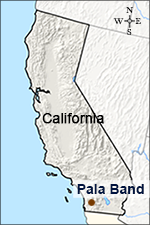 The Pala Band of Mission Indians’ reservation is located in San Diego County near the base of Palomar Mountain, about 40 minutes inland from the coast. The reservation, around 13,000 acres, is home to many of the tribe’s 900+ members. The land is typical of southern California’s dry Mediterranean climate, hilly and prone to wildfire danger. The land is also favorable to oak trees, its acorns providing one of the main staples of the traditional Pala diet.
The Pala Band of Mission Indians’ reservation is located in San Diego County near the base of Palomar Mountain, about 40 minutes inland from the coast. The reservation, around 13,000 acres, is home to many of the tribe’s 900+ members. The land is typical of southern California’s dry Mediterranean climate, hilly and prone to wildfire danger. The land is also favorable to oak trees, its acorns providing one of the main staples of the traditional Pala diet.
The Tribal Climate Health Project
In October 2016, the Pala Band of Mission Indians was awarded a five-year grant from the U.S. EPA for “Building the Capacity of Tribes to Address the Health Impacts of Climate Change.” The work was focused on developing an online, nationwide platform where tribes could learn about the health impacts of climate change. Tribes could utilize these resources to define health impacts and related action items in the process of drafting their own Climate Adaptation Plan. These resources would better equip tribes who wanted to ensure the health and well-being of tribal members in addressing the increasingly changing climate.
The following month, with a new incoming federal administration, the tribe learned that the EPA grant would be reduced to a single year of funding. The Pala Environmental Department (PED), however, successfully applied for additional funding from both the National Indian Health Board and the Bureau of Indian Affairs Tribal Resilience Program. With the supplemental funding, the Tribal Climate Health Project was able to continue. Shasta Gaughen, Director for the Pala Environmental Department, says that while some of the in-person components had to be converted to online components, largely their vision for the work remained intact. With a focus on climate change and health, the program includes a resource clearinghouse, tools, and templates for vulnerability assessment and adaptation planning, as well as online training opportunities.
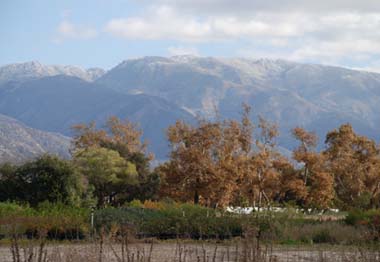
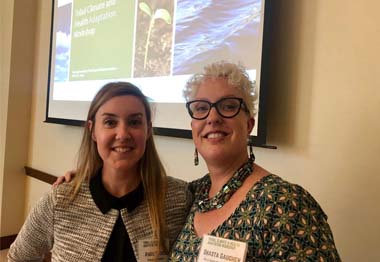
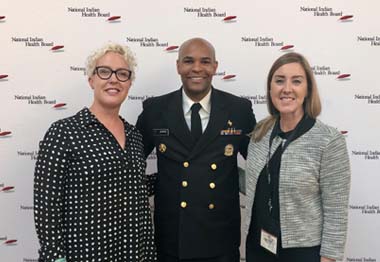
A Collaborative Framework
PED hired the consulting group, Prosper Sustainably, to spearhead the bulk of the work. PED also formed a community advisory group comprised of tribal members and staff to collaborate on the project. One of the conversations the advisory group kept returning to was how tribal needs differed based on location and cultural values. A toolset had to be equally beneficial for a rural tribe in the southwest as for an urban tribe in the northeast. Dr. Gaughen said one of the most challenging pieces was figuring out, “How to how to create a curriculum that is broad enough to be relevant to all tribes, but flexible enough to be customized for individual tribes.”
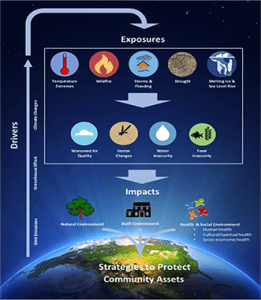
The Toolsets
In the spring of 2018, the Tribal Climate Health Project went live with their website. It is an invaluable platform. The site includes a searchable clearinghouse with over 500 resources related to health and climate change, with many articles specific to tribal issues. The team has also published two tools: a Climate Vulnerability Experiences and Priorities Survey and a beta version of the Exposures, Impacts, and Strategies Inventory (EISI) tool. For tribes who are just beginning the initial phases of a Climate Adaptation Plan, the survey helps assess community concerns including health-related topics. For tribes actively pursuing a Climate Adaptation Plan, the second tool breaks the process down into three stages with templates for evaluating potential threats of climate change by region, prioritizing potential threats for a single tribe, and evaluating and tracking adaptation strategies.
While direct impacts of climate change – for example, warming temperatures and rising oceans – are visibly evident, secondary health risks may not be so apparent. The EISI (pronounced “easy”) tool helps to identify what health impacts may result from a warming climate in a particular region. The first tab of the spreadsheet provides a chart organized by primary climate change impacts and secondary health risks. These are delineated out by eight regions of the U.S. For example, the chart indicates that seven out of eight regions may be subject to more severe storms and flooding as the climate warms. Related secondary health exposures include increased prevalence of mold, food and water contamination/disruption, and an increase in mosquitoes – all potential risks to health and well-being. Once a tribe has identified the primary and secondary exposures in their region, they can prioritize them on the second tab, and track actionable items on the third.
Generously, the Pala Tribe offers up their own Vulnerability Assessment and Climate Change Adaptation Plan (CCAP) as examples of how to integrate health exposures into strategic planning. During the Vulnerability Assessment, the tribe identified four high risk climate change impacts specific to the Pala tribe: Elevated Temperature, Wildfire, Storms and Flooding, and Drought. In the CCAP these four areas are further broken down by three areas of concern: Health and Social Environment, the Natural Environment, and Built Environments. In the Health and Social Environment section, the discussion spans human health, cultural and spiritual health, and socioeconomic health. In other words, climate change impacts on health and the strategies to combat those are integrated throughout the plan; they are not simply tacked onto the end.
Looking Forward
In June of 2019, the Tribal Climate Health Project held its first in-person training. Ten tribes, mostly from the west coast, were represented. Dr. Gaughen recalls, “The two-day workshop was great. We presented an overall framework for a step-by-step process that seemed flexible enough to be tailored to each community.”
Starting August of 2019, the Tribal Climate Health Project will host an online version of the training across ten sessions. Several tribes are registered, but in addition, representatives from city and state agencies are on the list as well as an EPA staff member. Dr. Gaughen is pleased. “I’m always hoping to find ways to reach out to diverse stakeholders.”
Once the online training has concluded, the sessions will be posted online, a free resource available to anyone who is interested. Dr. Gaughen hopes to continue fostering support for tribes who are considering embarking on their own adaptation plan. She imagines an online learning community as well as a possible peer-to-peer mentoring program.
If you would like to learn more about the Tribal Climate Health Project, head to their website, follow them on Facebook, or email them via their contact form.
Resources and References
- Tribal Climate Health website:
http://tribalclimatehealth.org/ - Climate Vulnerability Experiences and Priorities Survey
https://docs.google.com/forms/d/17NVn6Pv-xp7px5nZyd76IKBE2bB1dyJYlalJJRfFeHg/edit?usp=sharing - Exposures, Impacts, and Strategies Inventory (EISI) tool
http://tribalclimatehealth.org/wp-content/uploads/2019/04/EISI_Template_BETA_041619-1.xlsx - Pala Vulnerability Assessment
http://tribalclimatehealth.org/wp-content/uploads/2019/07/Pala_VulnAssess_Final-1.docx - Pala Climate Change Adaptation Plan (CCAP)
http://tribalclimatehealth.org/pala-adaptation-plan_final2clean/ - Tribal Health Training Opportunities
http://tribalclimatehealth.org/training-opportunities/
Project Contact:
Shasta C. Gaughen
Environmental Director/Tribal Historic Preservation Officer
Pala Band of Mission Indians
760-891-3515
sgaughen@palatribe.com
This profile was developed in September, 2019 by Amanda Kapp, Institute for Tribal Environmental Professionals, Northern Arizona University, with financial support from the Bureau of Indian Affairs Tribal Resilience Program. The profile is available on the Tribal Wellbeing for Seven Generations Program website: https://itep.nau.edu/twsgp/tribes/. The tribal profiles featured on the website are intended to be a pathway to increasing knowledge among tribal and non-tribal organizations interested in learning about climate change mitigation and adaptation efforts.
Special thanks to Shasta Gaughen for her assistance in developing this profile.
Citation: Kapp, A. (2019) The Pala Band of Mission Indians National Tribal Climate Health Project, August, 2019. Climate Change Program, Institute for Tribal Environmental Professionals, Northern Arizona University.
CONNECT WITH US
Nikki Cooley
Co-Director
Nikki.Cooley@nau.edu
Karen Cozzetto
Manager
Karen.Cozzetto@nau.edu
Your tax deductible donation supports ITEP’s programming efforts.
Please contact us if you would like to contribute to our endowment or for any additional information regarding donations.

